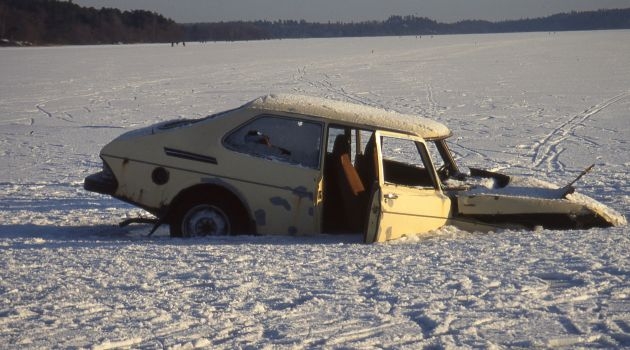Climate change ups the risk of going through the ice
Column
Many people like the idea of heading out onto the ice on a fine winter’s day. But how safe is it actually to walk on a frozen lake? Does ice behave in the same way in a warmer climate as it always used to? These questions have been central to an international sampling campaign, writes Gesa Weyhenmeyer, Professor of Aquatic Biogeochemistry.
Ecology and Genetics. Photo: David Naylor
We are used to seeing ice-covered lakes in the winter in Sweden. So far, there are only a few lakes in the country that no longer freeze in the winter, but this could change rapidly. More than 35,000 periodically frozen lakes in the northern hemisphere risk becoming completely ice-free if the mean global temperature continues to rise to two degrees warmer. As the climate has heated up, the number of accidents has increased. During the winter of 2020–2021, an unusually high number of people in Sweden went through the ice and more people than usual died. However, the greatest concern for ice safety is not a shorter period of ice cover or a complete lack of ice.
How much do we really know about the stability of ice? Of course, if you are an expert you know a good deal, but far from everyone can be regarded as an expert. An assessment of the stability of ice is usually based on the thickness of the ice, its acoustic characteristics and its appearance. Most members of the general public have learned that the ice needs to be about ten centimetres thick for it to be safe to walk on. But how true is that?
These questions were the starting point for an international sampling campaign that I initiated and that was performed in 2020–2021. The research campaign was carried out in ten countries in the northern hemisphere: Canada, the United States, Sweden, Finland, Latvia, Estonia, Russia, Germany, Switzerland and Italy. The results showed that it all depends what sort of ice is involved. If we are walking on clear black ice, just a few centimetres are needed for the ice to be considered stable and safe. However, if we are talking about white ice mixed with snow, not even ten centimetres is enough to bear the weight of a human being.
Most ice samples taken in the northern hemisphere during the winter of 2020–2021 showed a layer of clear ice in the bottom with a layer of white ice on top. The proportion of white ice generally increases towards the spring, when temperatures rise to around the freezing point. The warmer it grew, the more unstable the ice became, despite the thickness of the ice continuing to increase.
Does this mean that the quality of the ice changes when it becomes warmer? Yes, there is a clear connection. When the surface of the ice melts and refreezes, the large continuous ice crystals turn into smaller, loosely connected crystals that cannot bear as much weight. Though it is typically invisible to the naked eye, the ice generally becomes unstable and unsafe when temperatures fluctuate around the freezing point. And that is precisely when people enjoy being on the ice – when the sun is shining, the thermometer is above zero and the ice is more than 10 centimetres thick. The white surface makes the ice less scary.
Many thousands of people in Sweden use icy lakes for some type of activity every winter. What they need to do now is to adapt to the new, more unsafe ice conditions caused by increasingly variable temperatures and precipitation during the winter months. If you have always been in the habit of ice fishing on a certain day in February, it is very important now to check up on the quality of the ice – increasingly often, 10 centimetres of ice may mean you’re actually risking your life.
Gesa Weyhenmeyer, Professor at the Department of Ecology and Genetics, Limnology

